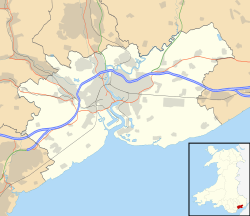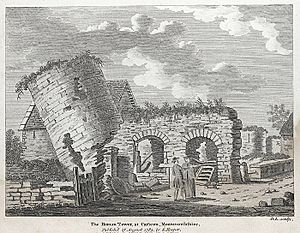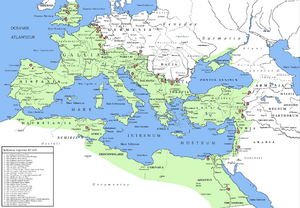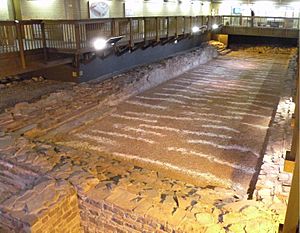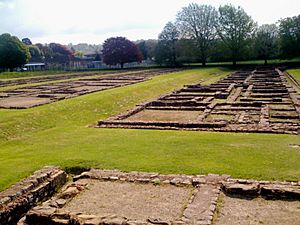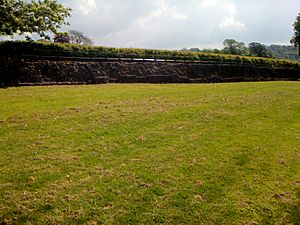Isca Augusta facts for kids
Quick facts for kids Isca Augusta |
|
|---|---|
| Caerllion (Welsh) | |
| Newport, Wales | |
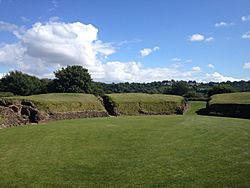
Caerleon amphitheatre
|
|
|
Location in Newport
|
|
| Coordinates | 51°36′37″N 2°57′32″W / 51.6103°N 2.9589°W |
| Grid reference | ST336909 |
Isca, also known as Isca Augusta or Isca Silurum, was a very important Roman army base and town. Its remains are now buried under parts of the modern town of Caerleon in Newport, South Wales. This amazing historical site includes the famous Caerleon Amphitheatre and is looked after by Cadw, a Welsh government group that protects historic places.
Isca was the main home for the Roman army's "II Augusta" legion. This legion was part of the Roman invasion of Britain in 43 AD. Isca is super important for understanding how the Romans took over, settled, and lived in Britannia (the Roman name for Britain). It was one of only three main Roman army bases in later Roman Britain. Unlike the other two, at Chester and York, Isca's old buildings are mostly untouched underground. This gives experts a special chance to study Roman soldiers in Britain. Even today, new discoveries are still being made!
Contents
What's in a Name?
The name Isca comes from an old Welsh word meaning "water." It refers to the River Usk that flows nearby. The word Augusta was added as a special honor, named after the Roman legion that stayed there. Sometimes, it was called Isca Silurum to tell it apart from another Roman town called Isca Dumnoniorum. It was also called this because it was in the land of the Silures tribe.
The later name, Caerleon, comes from the Welsh words for "fortress of the legion." This name clearly tells us what the place was: a strong Roman army base.
Building the Fortress: Isca's History
Isca was built around 74 or 75 AD. This was during the final battles led by Governor Sextus Julius Frontinus against the strong native tribes in western Britain. The Silures in South Wales had fought against the Romans for many years.
Isca became the main base for the Legion II Augusta. The fortress was shaped like a "playing-card" and was first built with earth banks and wooden fences. It stayed their main base until at least 300 AD. Inside, it had all the usual army buildings. There was a headquarters, homes for leaders, a hospital, a large bath house, workshops, and places for soldiers to sleep. It also had a big amphitheatre, which was quite unusual for a fortress.
At that time, there were four Roman legions in Britain. This was out of about 30 legions in the whole Roman Empire. This shows that Britain was a very important and heavily guarded area because it was a frontier. Each legion had over 5,000 highly trained soldiers. These soldiers joined the army for at least 20 years. They were the main force of the Roman army, conquering lands and building the Roman Empire. They brought new ideas and ways of life that changed Britain forever.
Around 99 or 100 AD, the fortress walls were made stronger. The original earth and wood defenses were replaced with a stone wall. This new wall was about 5 to 5.5 feet thick, with a clay bank behind it and a single ditch in front.
By 120 AD, parts of the legion were needed in other areas of Britain. Isca became more of a military base than a full garrison. However, it is believed that each group of soldiers, called a cohort, still had a presence at the fortress. When Septimius Severus became emperor in the 190s, Isca was repaired. The legion returned to rebuild after losing many soldiers in battles on the European continent.
More repairs happened under Emperor Caracalla. The southwest gate was rebuilt, the amphitheater was changed, and soldier barracks were fixed. The legion might have been called away to fight for one of the many emperors trying to gain power in the late 200s AD. Even though most of the fort was empty, a small group of soldiers likely stayed to keep things running. There was even more rebuilding work as late as the 270s.
The main military buildings were probably taken down by leaders like Carausius or Allectus. This happened when the legion was needed to stop a possible invasion from Europe. The stone from Isca might have been used to build defenses on the south coast of Britain. There might have been a few soldiers there in the early 300s, but the fortress was probably later used by people from the nearby town. For example, the large hall of the baths was even used as a place to keep cattle.
Recent discoveries show that Romans might have lived in some parts of Caerleon as late as 380 AD.
Early Christian Stories
According to old writings by a historian named Gildas (and later by Bede), Roman Caerleon was the place where two early Christians, Julius and Aaron, were killed for their beliefs. This happened around the same time as Saint Alban, who is known as the first British martyr. He was killed in the Roman city of Verulamium (near modern-day St Albans).
Gildas wrote that God helped Britain by bringing "bright lights of holy martyrs" during a time of persecution. He mentioned Saint Alban, and then Aaron and Julius from the "City of the Legions." This "City of the Legions" is thought to be Caerleon. This is because there were two old chapels there named after these martyrs. They were likely killed in 304 AD during a time when Christians were persecuted under Emperor Diocletian.
The Amazing Amphitheatre
Because of its round shape, the unexcavated amphitheater was known by local people as "King Arthur's Round Table." However, there is no real connection to King Arthur. In 1909, an early look at the site showed it would be great for a full excavation. This big dig started in 1926 and was led by Victor Erle Nash-Williams.
The excavation showed that the amphitheater was built around 80 AD. This first building was destroyed by fire in the early 100s. A second building was put up around 138 AD, but it was destroyed about 60 years later, around 196 or 197 AD. It was rebuilt for the third and last time between 197 and 211 AD. This third building was no longer used around the mid-300s, about the same time the Caerleon fortress was emptied. The newest coin found at this site is from the time of Emperor Valens (364–378 AD).
The arena inside is oval-shaped and has eight entrances. It is thought that about six thousand people could watch events there. Besides the usual gladiatorial shows, it was probably used for parades, displays, and training exercises by the soldiers from the fortress.
Roman Harbour Discovery
In August 2011, the remains of a Roman harbour were found in Caerleon. This shows that the Romans used the river for trade and transport.
What You Can See Today
You can still see many impressive Roman remains of the fortress at Caerleon today.
Cadw looks after these important sites:
- The military amphitheatre, which is one of the most amazing in Britain.
- Part of the military bath house, with the Caerleon Roman Fortress and Baths museum built right above it.
- The Prysg Field Barracks, which are the only Roman legionary barracks you can see in Europe.
- Parts of the fortress wall, which still stand about 12 feet (3.7 meters) high in some places.
National Roman Legion Museum
The National Roman Legion Museum is located in Caerleon. It is part of the National Museums and Galleries of Wales. The museum displays many interesting objects and finds from digs in the town and from nearby Burrium (Usk). These include Roman currency, weapons, parts of uniforms, and much more. It's a great place to learn about Roman life!
See also
 In Spanish: Isca Augusta para niños
In Spanish: Isca Augusta para niños


